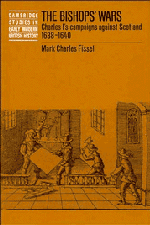Book contents
- Frontmatter
- Contents
- List of Maps
- Preface
- List of abbreviations
- 1 THE EVENTS OF THE BISHOPS' WARS AND CAROLINE POLITICS
- 2 INSTITUTIONS
- 3 MILITARY FINANCE
- 4 RELUCTANT LORDS AND ABSENT MERCENARIES
- 5 THE PERFECT MILITIA
- 6 IMPRESSMENT AND THE SUBSTITUTION CLAUSE
- 7 RIOT, ICONOCLASM, AND MURDER AMONGST THE SOLDIERY
- 8 CONCLUSION
- Bibliography
- Index
- Cambridge Studies in Early Modern British History
5 - THE PERFECT MILITIA
Published online by Cambridge University Press: 03 May 2011
- Frontmatter
- Contents
- List of Maps
- Preface
- List of abbreviations
- 1 THE EVENTS OF THE BISHOPS' WARS AND CAROLINE POLITICS
- 2 INSTITUTIONS
- 3 MILITARY FINANCE
- 4 RELUCTANT LORDS AND ABSENT MERCENARIES
- 5 THE PERFECT MILITIA
- 6 IMPRESSMENT AND THE SUBSTITUTION CLAUSE
- 7 RIOT, ICONOCLASM, AND MURDER AMONGST THE SOLDIERY
- 8 CONCLUSION
- Bibliography
- Index
- Cambridge Studies in Early Modern British History
Summary
Since the Middle Ages no monarch had tackled the problem of creating a trained military force for the defence of the realm with as much vigour as the young Charles I. During the war years of 1625-9 he aimed at fashioning an ‘exact’ or ‘perfect’ militia in England. Had he established a standing army or mobile regiments of trained-band soldiers, the civil wars might not have occurred. But he did not. Instead he reinvigorated tradition rather than innovated, by demanding that the trained bands fulfil their potential. However, the existence of the perfect militia did not hinder the Scots from crossing into England in 1640, nor did the trained bands flock to the royal standard in 1642.
Two questions dog any inquiry into the mobilizations of 1639 and 1640. Was the English militia capable of fighting the Covenanters? Tangentially, why did the King excuse trained soldiers from the expedition by allowing the substitution clause? This chapter argues that militia service, like military charges, was determined by the political relationship between the localities and the central government. Given the political and religious controversy surrounding the Scottish mobilizations, Charles could not make unqualified demands upon the military resources of the shires, especially as regards taking the militia out of the shire. Although the auxiliary role played by the trained bands in the Bishops' Wars was a direct result of the way in which the King mobilized his forces, the liability of the militia for such campaigning had developed over the centuries.
- Type
- Chapter
- Information
- The Bishops' WarsCharles I's Campaigns against Scotland, 1638–1640, pp. 174 - 214Publisher: Cambridge University PressPrint publication year: 1994
- 1
- Cited by



